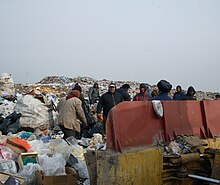This article has multiple issues. Please help improve it or discuss these issues on the talk page. (Learn how and when to remove these template messages)
|
Environmental racism in Central and Eastern Europe is well documented. In Central and Eastern Europe, socialist governments have generally prioritized industrial development over environmental protection, in spite of growing public and governmental environmental awareness in the 1960s and 1970s.[1]: 255 Even though public concern over the environmental effects of industrial expansion such as mine and dam construction grew in the late 1980s and early 1990s, policy makers continued to focus on privatization and economic development.[1]: 255 Following the market transition, environmental issues have persisted, despite some improvements during the early stages of transition.[1]: 255 Throughout this time, significant social restructuring took place alongside environmental changes.[1]: 255

According to K. Harper et al., "in the case of Roma in CEE [Central and Eastern Europe], spaces inhabited by low-income Roma have come to be 'racialized' during the post-socialist era, intensifying patterns of environmental exclusion along ethnic lines".[1]: 254 Romani peoples have inhabited Central and Eastern Europe for six hundred years and have traditionally worked or been employed as agricultural day laborers, musicians, tinsmiths (tinkers), and blacksmiths.[1]: 255 In the words of K. Harper et al.,
The interwar period and the post-socialist period, in their schema, were marked by downward mobility and increased spatial segregation of Roma communities in Hungary, Romania and Bulgaria. It is in the context of these cycles that patterns of environmental exclusion have come into being. More than 50 years after the social dislocations of World War II and the communist regime change, poor Roma settlements throughout the region are located on the outskirts of villages, separated from the majority population by roads, railways or other barriers, and disconnected from water pipelines and sewage treatment.[1]: 262
In analyzing environmental marginalization of Romani communities in Romania, anthropologist Enikő Vincze writes that "Environmental racism functions at the intersection of polluting the natural milieu, and of marginalizing social categories inferiorized by racial identification."[2]: 391 Throughout Central and Eastern Europe, Romani people themselves are often treated as environmentally problematic subjects.[1]: 262–3 Slovak authorities have been criticized by Romani rights activists over the alleged practice of "targeting Romani communities for forced evictions under the pretext of environmental law" by defining them as "waste dumps".[3]
In Central Europe, there have been documented cases within popular culture whereupon Romani populations are characterized as ecologically irresponsible. In Slovakia, the region near the transportation corridor between Prešov and Poprad is an important foraging area for Romani communities who collect mushrooms and berries during the summer for trade and direct consumption.[4]: 126 The activity is particularly significant due to the poor living conditions of many Romani in the area, who frequently take part in the illegal harvesting of state and private agricultural lands.[4]: 126 In 2006, a "popular magazine" published an article titled "Grasshoppers: While Roma from Tatra Region Make Money on Forests, Bears are Getting Hungry".[4]: 126 In the article, it was alleged that due to Romani foraging, Slovak bears could not find sufficient food to survive the winter.[4]: 127 Similarly, K. Harper et al write that Romani people in Hungary are viewed by majority culture as a group that "lacks environmental awareness" while simultaneously being "dissociated from any timeless connections to land":
Contemporary environmental discourses tend to portray marginalized and indigenous people in either of two ways: as noble savages or as environmental profligates (Krech, 1999). Unlike indigenous people, however, the Roma in Hungary are not associated with a timeless, revered 'environmental ethic'—perhaps because they were excluded from owning land (Csalog, 1994). In fact, the most destitute Roma have been chided for their short-sighted use of environmental resources: heating the house with forest wood and parts of the house itself (Ladányi and Szelényi, 2006 ...), engaging in extremely hazardous scrap metal processing and allegedly overharvesting snowdrop flowers to sell in the city. While many observers acknowledge the structural inequalities and histories underlying Roma communities' rural and post-industrial indigence, the fact remains that non-Roma widely see the Roma as a group that profoundly lacks environmental awareness.[1]: 263
- ^ a b c d e f g h i Harper, Krista; Steger, Tamara; Filčák, Richard (2009). "Environmental Justice and Roma Communities in Central and Eastern Europe". Environmental Policy and Governance. 19 (4): 251–268. CiteSeerX 10.1.1.893.1144. doi:10.1002/eet.511.
- ^ Cite error: The named reference
Vinczewas invoked but never defined (see the help page). - ^ Gökҫen, Sinan. "Slovak Republic Targets Roma Homes as 'Waste.'" Archived July 15, 2017, at the Wayback Machine European Roma Rights Centre. December 20, 2012. n. pag. Web. April 10, 2016.
- ^ a b c d Filčák, Richard. Living Beyond the Pale: Environmental Justice and the Roma Minority. Budapest: Central European University Press, 2012. Project MUSE. p. 5-163. Web. April 8, 2016.
